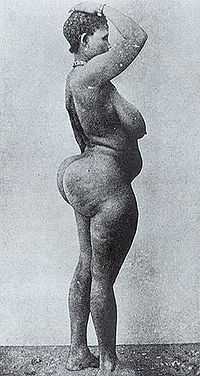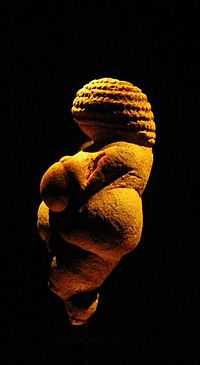Steatopygia

Steatopygia (/stiːˌætɵˈpɪdʒiə/;[1] Greek: στεατοπυγία) is a high degree of fat accumulation in and around the buttocks. The deposit of fat is not confined to the gluteal regions, but extends to the outside and front of the thighs, forming a thick layer reaching sometimes to the knee. It is often accompanied by the formation known as elongated labia (labia minora that may extend as much as 4 inches outside the vulva).
-

closeup of enlarged labia, spread
-

Khoisan women with pendulous labia visible
History
Steatopygia is a genetic characteristic of the Khoisan and some Bantu peoples. It is especially prevalent in women, but also occurs to a lesser degree in men. In most populations of Homo sapiens, females are more likely than men to accumulate adipose tissue in the buttock region. It has also been observed among the Pygmies of Central Africa and the Onge-tribe of the Andaman Islands.[2] Among the Khoisan, it is regarded as a sign of beauty. It begins in infancy and is fully developed by the time of the first pregnancy.
Steatopygia would seem to have been a characteristic of a population that once extended from the Gulf of Aden to the Cape of Good Hope, of which Khoisan and Pygmies are remnants. While the Khoisan are most noticeable examples, it occurs in other parts of Africa, and occurs even more frequently among male Basters than among Khoikhoi women.[citation needed] It is also observed among Andamanese Negrito women.
It has been suggested that this feature was once more widespread. Paleolithic Venus figurines, sometimes referred to as "steatopygian Venus" figures, discovered from Europe to Asia and presenting a remarkable development of the thighs, and even the prolongation of the labia minora, have been used to support this theory.[3] Whether these were intended to be lifelike or exaggeratory, even idealistic, is unclear. However, these figures do not strictly qualify as steatopygian, since they exhibit an angle of approximately 120 degrees between the back and the buttocks,[4] while steatopygia is diagnosed at an angle of about 90 degrees only.[citation needed]



See also
- Saartjie Baartman
References
- ↑ http://content.answers.com/main/content/ahd4/pron/S0728900.wav
- ↑ "Chapter 5: A Physical Examination". Andaman.org. Retrieved 2012-08-13.
- ↑ Anitei, Stefan (April 2007). "What is Steatopygia? An ancestral trait". Retrieved 2009-03-25.
- ↑ Passemard, L. (1938). Les statuettes féminines paléolithiques dites Vénus stéatopyges. Nîmes: Tessier.